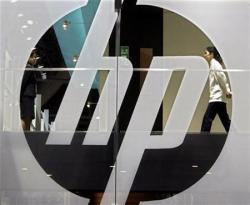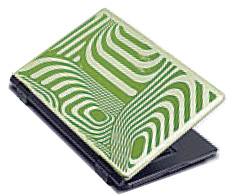Gabriel Madway
Sun

An employee walks past a Hewlett-Packard logo during the second day of the International Telecommunication Union (ITU) Telecom World 2006 in Hong Kong December 5, 2006. REUTERS/Paul Yeung

Hewlett-Packard’s new Mini 1000 notebook. Netbooks — ultraportable, inexpensive laptops designed for Web browsing and light tasks — have taken the PC market by storm this year. REUTERS/HP/Handout
SAN FRANCISCO – Hewlett-Packard Co on Wednesday will unveil a new mini-notebook in a move to gain ground in the fastest-growing PC category, which until now has been dominated by its smaller rivals.
Netbooks — ultraportable, inexpensive laptops designed for Web browsing and light tasks — have taken the PC market by storm this year, with smaller computer firms such as Acer Inc and Asustek Computer Inc leading the charge.
HP’s sleek new Mini 1000, costing about $400, is significantly different from the company’s first netbook release, launched last spring. It uses Intel Corp’s Atom processor, and is also substantially less expensive, signaling that the price war in netbooks that some analysts have been predicting may have begun.
Although still a fraction of the overall PC market, netbooks‘ popularity could lead to changes in the pecking order of PC makers and cut into margins and profitability as average selling prices come down.
In the third quarter, Acer gained ground on HP and Dell Inc, with a big assist from mini-notebooks.
According to industry tracker IDC, Acer’s total shipments leaped more than 50 percent, and the company’s share of the overall PC market climbed more than 3 percentage points to 12.5 percent.
HP, although still the top-selling PC maker, saw its overall market share dip slightly to 18.8 percent, and was outsold in Europe by Acer.
Analysts said the company was impacted by its delayed entry into the mini-notebook market.
Bob O’Donnell, vice president at IDC, estimates 10.8 million netbooks will ship in 2008, out of the more than 300 million overall PC shipments forecast for the year. He expects netbook shipments to jump to 20.8 million in 2009.
Carlos Montalvo, vice president of marketing in HP’s managed home business, said the Mini 1000 is a superior product to the “second- and third-tier” offerings from competitors, which he said have been “over-optimized” for size and price, and lack HP’s consistency and quality.
Without releasing specific numbers, Montalvo said HP’s first netbook, which was targeted at the education market, was “phenomenally successful.” However, he said the Mini 1000 is aiming for a broader audience.
The new netbook will start at $399 for a version running Microsoft Corp’s Windows XP, jumping to $549 for a fully loaded model. The company’s first netbook, the 2133, starts at $599 and tops out at $749, features a Via chip and runs Windows Vista.
HP will also offer a Mini 1000 that runs Linux for $379, as well as a special edition designed by fashion designer Vivienne Tam for $699.
The netbooks will all feature a keyboard that is 92 percent the size of a standard keyboard, and will weigh less than three pounds.
NETBOOKS ROLE DEBATABLE
Although Montalvo views HP’s netbooks as complementary products, which a consumer would own in addition to their desktop or full-sized laptop, analysts don’t necessarily see it the same way.
Jayson Noland, an analyst with Robert Baird, said last week that netbooks‘ place in the PC universe is still undefined.
“I don’t think any of us knows yet whether it’s a substitute product or a complementary one,” said Noland. “In some markets in a mature economy like the U.S. or Western Europe it could be complementary, and in an emerging market it could be substitute.”
Also uncertain is netbooks‘ impact on the balance sheet. IDC’s O’Donnell fully expects to see a price war in netbooks, as companies try to boost sales to make up for the low price points.
“If you’re down to $300, then your profit margin goes away, so you have to make it up in volume. Their goal is all about high volume, low margin, and I think that’s going to be a challenge.”
Noland said both HP and Dell have been a little late to catch on to the appeal of netbooks, but he expects them to regroup without much trouble. Dell introduced its first netbook in September.
However, Apple has been openly dismissive of the product.
Apple Inc Chief Executive Steve Jobs, on a conference call after the company’s earnings, said the iPhone does many of the things that netbooks do, and said there were markets that the company was just not interested in.
“There are some customers which we choose not to serve. We don’t know how to make a $500 computer that’s not a piece of junk.”
© Reuters 2008












